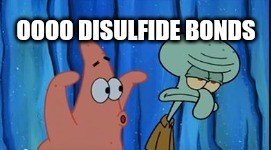Good rule of thumb: if someone else hasn't solved the problem yet, it's more complicated than you're assuming. If the problem is worth solving, other people smarter than you have almost certainly attempted the easy "solutions" already, and they were inadequate to solve the problem. Heck, even if it's not worth solving, there's a non-zero chance that some pre-Reagan weirdos took a crack at it with bonus mercury and thallium compounds for the lulz and published it all in a vague 200-word comm in a now-defunct journal.
Isn't the squaring actually multiplication by the complex conjugate when working in the complex plane? i.e., √((1 - 0 i) (1 + 0 i) + (0 - i) (0 + i)) = √(1 + - i^2^) = √(1 + 1) = √2. I could be totally off base here and could be confusing with something else...
New strategy to prevent global warming: just freeze all of the CO2 out of the air!
inhales
Complex 1a was prepared according to well-known synthetic procedures. The reduction potential of the complex was increased due to the nephelauxetic expansion of the occupied FMOs induced by photolytic epimerization of the auxiliary tetrahydrophosphazolidine sulfide ligand to enable a strongly σ-donating dihaptic coordination mode.
translation: we made molecule 1a, we shouldn't need to tell you how, it's obvious, lmao, git gud. the molecule became less likely to gain extra electrons because shining light on it made one of its weird-ass totally-not-bullshit parts wiggle around a bit so that it could bind more strongly to the metal atom through two of its own adjacent atoms, making the metal atom's relevant electrons floofier.
Counterpoint: advisor said no.
"Just use Word, everyone else does. I have never heard of this latex thing, so must be just some trendy useless overengineered software that does Word's job but worse. Word can track changes just fine, and you can leave comments." proceeds to strikethrough, highlight, and inline comment everything instead of using either of those features "I want to read what you wrote, not fight technology" proceeds to email you three separate times after forgetting to attach v28 about how a graphic looks wrong because Word ate it
"Proper" conjugations are not totally settled, especially given its slang nature. Yeet does feel like it might be strong (stem-changing), though there's really no authority on it. Interestingly, I found through googling that there is a version of the verb yeet stemming from Middle English verb yeten, which has two variations. The first meant "to address with the pronoun ye" (e.g., as opposed to thou) and had weak conjugations (i.e., yeeted/yeted). The other sense referred to pouring or moving liquids and could be either strong or weak (simple past: yet or yote, or yeted; participle: yote, yoten, yeted). So, looking for historical comparisons is also unhelpful.
Edited for TLDR: no one knows, both forms have historical support; it doesn't matter, go crazy
fails self-restraint check
gen β, not ß
- edited to correct a tragic ragey blunder
touch benzene
get cancer
don't have to take exam
I see no downside
Sawdust is not (just) cellulose and cannot be listed as such on nutrition labels. Sawdust, i.e., wood shavings, contains many other compounds, especially lignin. Wood is refined by e.g. the Kraft process to separate the lignin from the cellulose, giving a suspension of cellulose fibers in water called "wood pulp." I didn't look, but I would imagine that calling wood pulp "cellulose" on a nutrition label is fine, 'cause that's what it is.
Now, none of this invalidates the crux of your argument that cellulose can be used as a cheap filler, such as in cheap "Parmesan cheese," and no disagreement here that that shit is scummy af. However, there are some legitimate uses for smaller amounts in foods, such as anti-caking, thickening, and literal dietary fiber.

cries in hypertension